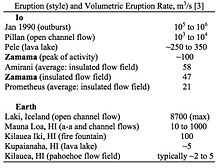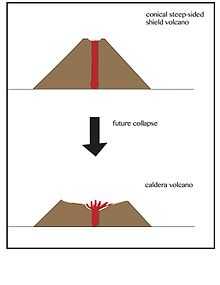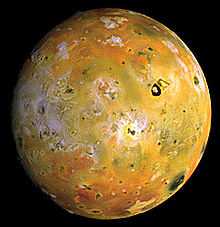Zamama (volcano)

Zamama is an active volcanic center on Jupiter 's moon Io.[1][2] This volcanic center erupted after the Voyager 1 flyby in 1979 which makes it one of the few planetary volcanoes known to have started within human life span. Further analysis and study by the Galileo spacecraft helped with the overall study of Io's volcanism. Galileo located it on Io at 21°N 173°W / 21°N 173°W[3][1]Coordinates: 21°N 173°W / 21°N 173°W[3][1]. Zamama originated from fissure-fed flow which is 150 km (93 mi) long with temperatures of 1,100 K (830 °C; 1,520 °F).[1] The Zamama volcanic center site has explosive and effusive eruption characteristics. It is a host for multiple steep-sided shield volcanoes (Zamama A, B and C).[4] Zamama field flow is longer than 100 km (62 mi) that emits SO2 plumes and sulfur flows. The flow appears to be emanating from the Promethean-type volcano. Remote sensing instruments were built on the Galileo spacecraft—Near-Infrared Mapping Spectrometer (NIMS), Solid-State Imager (SSI), Photopolarimeter-Radiometer (PPR)—to collect and analyze volcanism on Io's surface. Since there are no samples collected from Io, all of the interpretations are made by studying albedo effects, morphology and/or spectral variations in Galileo data. Furthermore, Geomorphologic analysis is strictly used to study such specific planetary structure (Zamama) and it was formally called South Volund[1] in the Voyager period.[5]
Overview of the Voyager and Galileo missions
Most of the data acquired from the Jovian moon Io were derived from geomorphologic interpretations of orbital imaging. Voyager 1 and Galileo both have used thermal remote sensing. It is a branch of remote sensing which deals with processing and interpretations of data in the thermal infrared (TIR) region of the electromagnetic (EM) spectrum. However, Zamama is a hotspot/volcanic center among 61 active volcanic centers on Io.[6] These were observed by the Voyager flybys, Galileo, and ground-based observations. Zamama was first observed by Galileo, which showed red bright deposits; the associated color for active volcanic centers/hotspots.[6] Galileo have shown two types of volcanic activity: persistent and sporadic.[6] The NIMS instrument detected longer than one year activity in Zamama, therefore it is considered of the persistent type[6] and it has been NIMS-detected five times but only NIMS-observed nine times. Lesser detections could be due to observational constrains or temporary waning of activity.[6]
Volcanism on Zamama
Volcanic topography

Io is one of the most challenging Jovian moons to establish topography. A couple techniques aided in the making Io's topography such as "3D" stereo photogrammetry (SP) and "2D" photoclinometry (PC).[4] However, Ionian volcanoes have been poorly characterized because of their volcanic construct which is different than well-studied planetary volcanoes such as the Martian volcanoes. Nevertheless, two common flow field morphologies have been identified on Io:[4]
- Large broad irregular flows (flow sheets).
- Radially centered flow fields.
_marked_by_White_arrows._Zamama(A)_shield_volcano_and_the_dark_main_flow_comples_spreading_eastward..jpg)
Zamama active volcanic center is characterized morphologically by a radially centered flow field. In this area lies multiple steep-sided shield volcanoes:
- Zamama A (18°N, 175°W), is about 40 km (25 mi) wide, 1.5 km (0.93 mi) high, and has an average slope of 40°. Slope and height were estimated by PC. It extends about 140 km (87 mi) east and beyond the topographic margin of the observed steep-sided shield.[4] Zamama A is the source of the Zamama flow field.[7] The origin of volcanism is both siliceous and sulfuric, although Zamama originates from a Prometheus-type plume.[7]
- Zamama B is located 75 km (47 mi) southeast of Zamama A, and is about 40 km (25 mi) wide and 1–1.5 km (0.62–0.93 mi) high. Height were estimated by PC shadow measurements.[4]
- Zamama C (15°N, 170°W) is located 175 km (109 mi) southeast of the Zamama volcanic center, is about 250 m (820 ft) high, and has a slope that ranges between 3°-5°. Height was determined by PC.[4]
Surface changes
Zamama appears to be inactive during the 1979 Voyager 1 visit or it might have been buried by the Volund deposits. In the Galileo observations, Zamama showed to be a very active hot spot. Zamama has shown three notable surface changes in the SSI collected images. First, the most prominent central eruption took place (18° N, 171° W). Images show them as a bright ring placed within the dark lava flows with a diameter of about 370 km (230 mi). In addition, new black deposits were deposited north and northeastern of the central prominent eruption. The total area changed was about 136,000 km2 (53,000 sq mi). Second, a new eruption caused broadening in the central dark deposits of the western side and new bright deposits were deposited along the margins of the lava flows. The total area effected was about 37,000 km2 (14,000 sq mi). Third, Zamama's third plume was actively erupting while Galileo was on orbit number 14 around Jupiter. New deposits have enlarged to 150 ± 5 km (93.2 ± 3.1 mi) and are centered east of the eruptive center. Total affected area was about 96,000 km2 (37,000 sq mi).[8]
Temperature

Galileo 's NIMS instrument collected data on volcanic emissions to analyze the power output. A two-temperature model is used to determine the temperature and power output. Models have shown that Zamama has a temperature of 1,173 ± 243 K (900 ± 243 °C; 1,652 ± 437 °F). Pyroclastic flows with high silica content can have temperatures as high as 1,200 °C (1,470 K; 2,190 °F). Since Zamama volcanoes have such high temperature, this indicates siliceous magma. No actual samples of Zamama's magma have been retrieved and processed for composition.[9]
Composition
Lava flows at Zamama suggest that it is a shield volcano with a central vent and a rift zone. The rift zone seems to feed the dark flow field which appeared in the Galileo visit. The flow field appeared narrow and thin closer to the center, and wide/broad away from the center. This behavior might be due to a change in slope from the volcano rim to the nearby plains. The central vent emanates bright flows, due to sulfurous lava composition or silicate lava coated by sulfurous deposits. The composition of the lava emitted from the volcano is still mysterious.[7]
Volcanic parameters

NIMS data analysis was made to determine the variability of thermal emissions from volcanoes on Io—particularly Zamama—for 1038 days (28 June 1996 to 2 May 1999) and the results showed:[5]
- Average volumetric rates decrease at the beginning of the period which indicate lessening in diffusive activity, or cooling of old flow surface. Later, there is an increase in volcanic activity indicating the beginning of an eruption.
- Total power output observed at Zamama was 1.25×1019 J.
- Average power output 139.8 GW.
- Total volume erupted through this period was 3.5 ± 1.4 km3 (0.84 ± 0.34 cu mi).
- Average volumetric flux was 39.4 ± 15.5 m3/s (1,390 ± 550 cu ft/s).
Comparison and evolution
Comparisons with Ionian and terrestrial volcanoes
- Zamama has lower volumetric emission rates compared to various styles of eruptions on Io.[5]
- Zamama is more powerful than its terrestrial counterparts such as Kīlauea, Hawaii.[5]
- In general, Io's eruptions have larger volumetric fluxes and active areas than terrestrial volcanoes, compared with volcanoes of the same eruption style.[5]
Evolution of Ionian shield volcanoes

Most Ionian volcanoes start as steep-sided shield volcanoes. After an eruptive construct-building phase, the central region collapses to form a caldera. Since steep-sided shield volcanoes have not been observed inside collapsed calderas, this indicates a failure to reform steep-sided volcanoes after the collapse, which can be associated with various variables such as change in temperature, eruptive rate, and/or lava composition. Failure to reform shield volcanoes is caused by failure to supply magma through the magma chamber. These interpretations might be a sign for future change in shield volcanoes in which they will transform to caldera-forming eruptive sites.[4]
Future work
Future work on Io's volcanism is mentioned by Lopes-Gautier (1999) "regarding global thermal maps from NIMS, a global topographic map SSI data and a global topographic map SSI data will seek to clarify the distribution of cold bright white regions and local concentrations of hotspots reflect the distribution of internal heating or local differences in crustal thickness".[6]
References
- ↑ 1.0 1.1 1.2 1.3 1.4 Davies, Ashley Gerald; McEwen, Alfred S.; Lopes-Gautier, Rosaly M. C.; Keszthelyi, Laszlo; Carlson, Robert W. et al. (October 1997). "Temperature and area constraints of the South Volund volcano on Io from the NIMS and SSI instruments during the Galileo G1 orbit". Geophysical Research Letters 24 (20): 2447–2450. Bibcode:1997GeoRL..24.2447D. doi:10.1029/97GL02310.
- ↑ McEwen, Alfred S.; Simonelli, Damon P.; Senske, David R.; Klaasen, Kenneth P.; Keszthelyi, Laszlo et al. (October 1997). "High-temperature hot spots on Io as seen by the Galileo Solid State Imaging (SSI) experiment". Geophysical Research Letters 24 (20): 2443–2446. Bibcode:1997GeoRL..24.2443M. doi:10.1029/97GL01956.
- ↑ 3.0 3.1 Davies, Ashley Gerard (2007). Volcanism on Io: A Comparison with Earth. Cambridge University Press. Bibcode:2007vice.book.....D. ISBN 978-0-521-85003-2.
- ↑ 4.0 4.1 4.2 4.3 4.4 4.5 4.6 Schenk, P. M.; Wilson, R. R.; Davies, A. G. (May 2004). "Shield volcano topography and the rheology of lava flows on Io". Icarus 169 (1): 98–110. Bibcode:2004Icar..169...98S. doi:10.1016/j.icarus.2004.01.015.
- ↑ 5.0 5.1 5.2 5.3 5.4 Ennis; M. E.; Davies, A. G. (March 2005). Thermal Emission Variability of Zamama, Culann and Tupan on Io Using Galileo Near-Infrared Mapping Spectrometer (NIMS) Data. 36th Annual Lunar and Planetary Science Conference. 14-18 March 2005. League City, Texas. 1474. Bibcode:2005LPI....36.1474E.
- ↑ 6.0 6.1 6.2 6.3 6.4 6.5 Lopes-Gautier, Rosaly; McEwen, Alfred S.; Smythe, William B.; Geissler, P. E.; Kamp, L. et al. (August 1999). "Active Volcanism on Io: Global Distribution and Variations in Activity". Icarus 140 (2): 243–264. Bibcode:1999Icar..140..243L. doi:10.1006/icar.1999.6129.
- ↑ 7.0 7.1 7.2 Keszthelyi, L.; McEwen, A. S.; Phillips, C. B.; Milazzo, M.; Geissler, P. et al. (December 2001). "Imaging of volcanic activity on Jupiter's moon Io by Galileo during the Galileo Europa Mission and the Galileo Millennium Mission". Journal of Geophysical Research 106 (E12): 33025–33052. Bibcode:2001JGR...10633025K. doi:10.1029/2000JE001383.
- ↑ Geissler, Paul; McEwen, Alfred; Phillips, Cynthia; Keszthelyi, Laszlo; Spencer, John (May 2004). "Surface changes on Io during the Galileo mission". Icarus 169 (1): 29–64. Bibcode:2004Icar..169...29G. doi:10.1016/j.icarus.2003.09.024.
- ↑ Davies, Ashley Gerard (September 2003). "Volcanism on Io: Estimation of eruption parameters from Galileo NIMS data". Journal of Geophysical Research 108 (E9): 5106–5120. Bibcode:2003JGRE..108.5106D. doi:10.1029/2001JE001509.
Further reading
- Williams, David A.; Keszthelyi, Laszlo P.; Schenk, Paul M.; Milazzo, Moses P.; Lopes, Rosaly M. C. et al. (September 2005). "The Zamama–Thor region of Io: Insights from a synthesis of mapping, topography, and Galileo spacecraft data". Icarus 177 (1): 69–88. Bibcode:2005Icar..177...69W. doi:10.1016/j.icarus.2005.03.005.
- Davies, Ashley Gerard; Lopes-Gautier, Rosaly; Smythe, William D.; Carlson, Robert W. (November 2000). "Silicate Cooling Model Fits to Galileo NIMS Data of Volcanism on Io". Icarus 148 (1): 211–225. Bibcode:2000Icar..148..211D. doi:10.1006/icar.2000.6486.
| ||||||||||||||||||||||||||||||||
